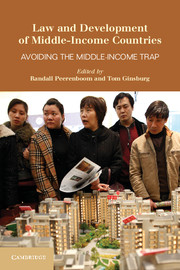Book contents
- Frontmatter
- Contents
- List of Contributors
- Acknowledgments
- 1 Law and Development in Middle-Income Countries
- Part I The Politics of Development in Middle-Income Countries
- Part II Middle-Income Countries in a Globalized Economy
- 4 The Rise of Middle-Income Countries in the International Trading System
- 5 The Middle Intellectual Property Powers
- 6 Growing Wealth in East Asian Middle-Income Countries with Transnational Production Regimes
- Part III Good Governance and the Rule of Law in Middle-Income Countries
- Part IV Socioeconomic Challenges in Middle-Income Countries
- Part V International Donor Strategies for Middle-Income Countries
- Appendix Selected Country Data as of 2011
- Index
- References
5 - The Middle Intellectual Property Powers
Published online by Cambridge University Press: 05 June 2014
- Frontmatter
- Contents
- List of Contributors
- Acknowledgments
- 1 Law and Development in Middle-Income Countries
- Part I The Politics of Development in Middle-Income Countries
- Part II Middle-Income Countries in a Globalized Economy
- 4 The Rise of Middle-Income Countries in the International Trading System
- 5 The Middle Intellectual Property Powers
- 6 Growing Wealth in East Asian Middle-Income Countries with Transnational Production Regimes
- Part III Good Governance and the Rule of Law in Middle-Income Countries
- Part IV Socioeconomic Challenges in Middle-Income Countries
- Part V International Donor Strategies for Middle-Income Countries
- Appendix Selected Country Data as of 2011
- Index
- References
Summary
INTRODUCTION
Since a large group of developing countries joined the international intellectual property regime following the decolonization movement, developed countries and their developing counterparts have engaged in a half-century-long debate over the appropriate standards for protecting and enforcing intellectual property rights. While developed countries complain about how the standards are insufficient to meet the needs of their growing intellectual property interests, developing countries are frustrated by how the very same standards have stifled access to essential medicines, knowledge, information and communication technologies, and other key development resources.
As is typical of any debate involving the North-South divide, the international intellectual property debate is binary and highly polarized; it involves two sides that insist on their own positions while expecting the other side to change. In recent years, however, that debate began to slowly change following the emergence of a core group of middle-income countries (MICs). Although these countries continue to struggle with traditional Southern economic, technological, and development challenges, their high levels of technological proficiency and innovative capacity have allowed them to share some common interests with the developed North.
- Type
- Chapter
- Information
- Law and Development of Middle-Income CountriesAvoiding the Middle-Income Trap, pp. 84 - 107Publisher: Cambridge University PressPrint publication year: 2014
References
- 3
- Cited by

